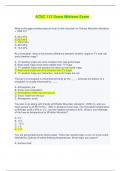Atsc 113 sailing - Study guides, Class notes & Summaries
Looking for the best study guides, study notes and summaries about Atsc 113 sailing? On this page you'll find 8 study documents about Atsc 113 sailing.
All 8 results
Sort by
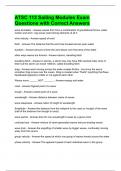
-
ATSC 113 Sailing Modules Exam Questions with Correct Answers
- Exam (elaborations) • 10 pages • 2024
- Available in package deal
-
- $14.49
- + learn more
ATSC 113 Sailing Modules Exam Questions with Correct Answers capillary wave - Answer-wind generated, small, short wavelength, acts as a restoring force with the water's surface tension gravity wave - Answer-wind-generated, gravity acts as restoring force, meters to kilometres long swell - Answer-formed by distant storms, gravity waves that travel long distances with little loss of energy - they take the shortest distance on the earth, curve-like rogue waves - Answer-these freak wave...
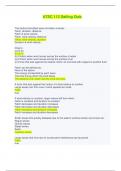
-
ATSC 113 Sailing Weather Quiz - Questions with correct Answers
- Exam (elaborations) • 20 pages • 2023
-
Available in package deal
-
- $16.49
- + learn more
ATSC 113 Sailing Weather Quiz - Questions with correct Answers The factors that affect wave formation include: Fetch, duration, distance Fetch & wind velocity Fetch, wind velocity, distance Fetch, wind velocity, duration Duration & wind velocity Drag is: (a) & (b) (b) & (c) (b) Friction when wind moves across the surface of water (a) Friction when wind moves across the surface of air (c) Force that acts against the relative motion of one fluid with respect to another fluid Fetch can be defined ...
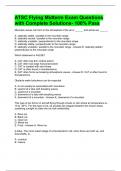
-
ATSC Exam Bundle (Graded A+)
- Package deal • 28 items • 2024
-
- $35.49
- + learn more
ATSC Learning Goals Exam Questions with Correct Answers 2 Exam (elaborations) ATSC Flying Midterm Exam Questions with Complete Solutions- 100% Pass 3 Exam (elaborations) ATSC Exam 3 Questions and Answers 4 Exam (elaborations) ATSC 113 SNOW Exam Questions with 100% Correct Answers (Graded A+) 5 Exam (elaborations) ATSC 113 Sailing Modules Exam Q
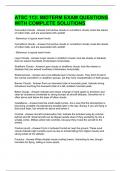
-
ATSC 113: MIDTERM EXAM QUESTIONS WITH COMPLETE SOLUTIONS
- Exam (elaborations) • 12 pages • 2024
- Available in package deal
-
- $14.49
- + learn more
ATSC 113: MIDTERM EXAM QUESTIONS WITH COMPLETE SOLUTIONS Lenticular (mountain-wave) clouds - Answer-Indicate vertical wind oscillations and possible mountain-wave turbulence. Sailplanes like the updraft portion of the waves, because they can "surf" the wave and fly very long horizontal distances. Commercial aircraft hate the waves because they often mean a very bumpy ride at all altitudes for the whole time while flying over the mountains. Pileus - Answer-Form over fast-growing cumulus...

-
ATSC 113(ATSC Applied Quiz-University of British Columbia
- Exam (elaborations) • 5 pages • 2023
-
- $10.49
- + learn more
ATSC 113(ATSC Applied Quiz-University of British Columbia Mesoscale Correct answer- What is the scale-name for the thunderstorms discussed in the Flying Weather theme? synoptic micro gamma or delta micro alpha or beta global / planetary mesoscale synoptic Correct answer- What is the scale-name for the larger-scale warm-frontal clouds discussed in the Flying Weather and Snow-sports Weather themes? Namely, what is the scale related to the length of the warm front, not its w...
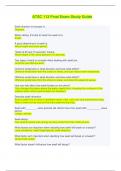
-
ATSC 113 Final Exam Study Guide
- Exam (elaborations) • 7 pages • 2023
-
Available in package deal
-
- $10.99
- + learn more
ATSC 113 Final Exam Study Guide Swell direction is forecast in: Degrees. When sailing, it's best to head into swell at a: Angle. A good determinant of swell is: Wave height and wave period. "Swell of 6ft and 15 seconds" means: Wave height of 6ft, wave period of 15 seconds. Two types of wind to consider when dealing with swell are: Onshore and offshore wind. Onshore winds blow in what direction and have what effect? Onshore winds blow from the ocean to shore, and can reduce wave steepness. Of...
ATSC 113 Snow Weather Midterm Exam | ATSC 113 Flying Weather Midterm Exam | ATSC 113 Sailing Weather Quiz | ATSC 113 Final Exam Study Guide
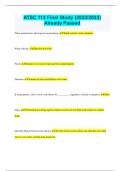
-
ATSC 113 Final Study (2022/2023) Already Passed
- Exam (elaborations) • 13 pages • 2023
-
Available in package deal
-
- $9.99
- + learn more
ATSC 113 Final Study (2022/2023) Already Passed Three main factors affecting wave formation: Wind velocity, fetch, duration. Wind velocity: Speed of the wind. Fetch: Distance over water wind can blow uninterrupted. Duration: Amount of time wind blows over water. If wind speed is slow, waves will always be _________, regardless of fetch or duration. Slow Drag: Frictional force acting against relative motion of one fluid with respect to another fluid. Describe drag between ocean and air. Tex...

That summary you just bought made someone very happy. Also get paid weekly? Sell your study resources on Stuvia! Discover all about earning on Stuvia



